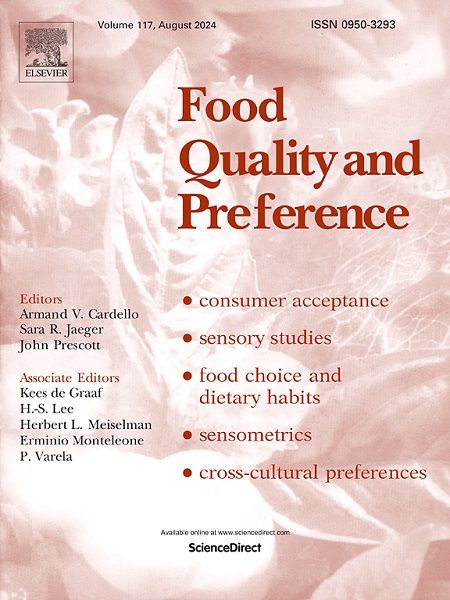Three independent measures of sweet taste liking have weak and inconsistent associations with sugar and sweet food intake - insights from the sweet tooth study
IF 4.9
1区 农林科学
Q1 FOOD SCIENCE & TECHNOLOGY
引用次数: 0
Abstract
Authoritative public health agencies, like the WHO, recommend reducing dietary sweetness to lower sweet liking, and thereby indirectly lowering sugar and energy intake. However, data on an association between sweetness liking and sugar/sweet food intake are inconsistent. Moreover, sweetness liking can be measured in various ways, and the agreement between methods is unclear. Baseline data from the Sweet Tooth study (n = 178) were used to evaluate the agreement between three different measures of sweetness liking and their association with sugar and sweet food intake. Sweetness liking was assed by: 1) psychohedonic sweetness functions, 2) sweet liker phenotype, and 3) self-reported sweet / fat-sweet preference. Sugar and sweet food intake were assessed via 24-h recall and a FFQ assessing the consumption of food groups based on taste (TasteFFQ). On a group level, the three sweetness liking measures showed similar results; sweet liker phenotype showed higher liking of high sweetness levels (F(2,175) = 27.9, p < .001), and higher preference for sweet and fat-sweet foods (sweet: χ2(2) = 16.2, p < .001, sweet-fat: χ2(2) = 24.8;p < .001). Self-reported preferences for sweet foods were associated with intake of simple sugars (χ2(1) = 6.10, p = .014), energy (χ2(1) = 5.82, p = .016), and sweet foods (χ2(1) = 5.05, p = .025). Neither the psychohedonic functions, sweet liker phenotype nor self-reported fat-sweet preferences were associated with sugar and/or sweet food intake (all p > .05). These findings suggest that, while sweetness preferences can be measured using different approaches, high sweetness liking has only a limited relationship with actual sugar and sweet food intake. These findings challenge the assumption that preferences for sweet tastes drive high intakes of sweet foods and sugars.
Ethical approval for the involvement of human subjects in this study was granted by METC-WU, ABR nr. NL72134, 10/05/20.
三种独立的甜味偏好与糖和甜食摄入量之间的联系微弱且不一致——来自甜食研究的见解
权威的公共卫生机构,如世界卫生组织,建议减少饮食中的甜味,以降低对甜味的喜爱,从而间接降低糖和能量的摄入量。然而,关于甜味喜好和糖/甜食摄入量之间关系的数据并不一致。此外,人们对甜味的喜爱程度可以通过多种方式来衡量,而不同方法之间的一致性尚不清楚。来自甜食研究的基线数据(n = 178)被用来评估三种不同的甜味偏好之间的一致性,以及它们与糖和甜食摄入量之间的关系。甜味偏好由以下几个方面组成:1)甜味心理愉悦功能;2)甜味偏好表型;3)自我报告的甜/脂甜偏好。通过24小时回忆和基于味道评估食物组消费的FFQ (TasteFFQ)来评估糖和甜食的摄入量。在群体层面上,三种甜味喜好测量结果相似;嗜甜表型显示对高甜度的喜爱程度较高(F(2175) = 27.9, p <;.001),对甜食和高脂甜食的偏好更高(χ2(2) = 16.2, p <;.001,糖脂:χ2(2) = 24.8;p <;措施)。自我报告的甜食偏好与单糖的摄入量(χ2(1) = 6.10, p = 0.014)、能量(χ2(1) = 5.82, p = 0.016)和甜食(χ2(1) = 5.05, p = 0.025)有关。心理享乐功能、嗜甜表型和自我报告的脂肪-甜味偏好都与糖和/或甜食摄入无关(所有p >;. 05)。这些发现表明,虽然人们对甜味的偏好可以通过不同的方法来衡量,但对甜味的喜爱程度与实际摄入的糖和甜食只有有限的关系。这些发现挑战了人们对甜味的偏好导致甜食和糖的高摄入量的假设。meta - wu, ABR号NL72134, 10/05/20批准了人类受试者参与本研究的伦理批准。
本文章由计算机程序翻译,如有差异,请以英文原文为准。
求助全文
约1分钟内获得全文
求助全文
来源期刊

Food Quality and Preference
工程技术-食品科技
CiteScore
10.40
自引率
15.10%
发文量
263
审稿时长
38 days
期刊介绍:
Food Quality and Preference is a journal devoted to sensory, consumer and behavioural research in food and non-food products. It publishes original research, critical reviews, and short communications in sensory and consumer science, and sensometrics. In addition, the journal publishes special invited issues on important timely topics and from relevant conferences. These are aimed at bridging the gap between research and application, bringing together authors and readers in consumer and market research, sensory science, sensometrics and sensory evaluation, nutrition and food choice, as well as food research, product development and sensory quality assurance. Submissions to Food Quality and Preference are limited to papers that include some form of human measurement; papers that are limited to physical/chemical measures or the routine application of sensory, consumer or econometric analysis will not be considered unless they specifically make a novel scientific contribution in line with the journal''s coverage as outlined below.
 求助内容:
求助内容: 应助结果提醒方式:
应助结果提醒方式:


